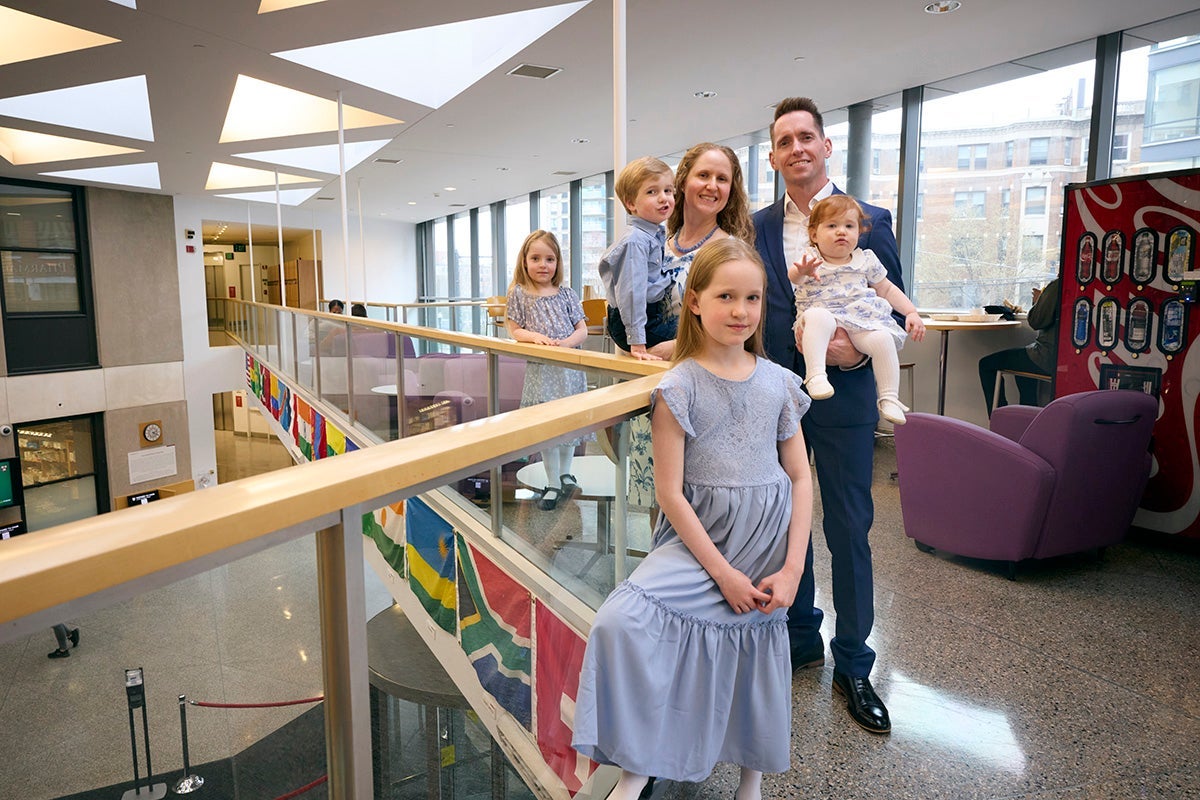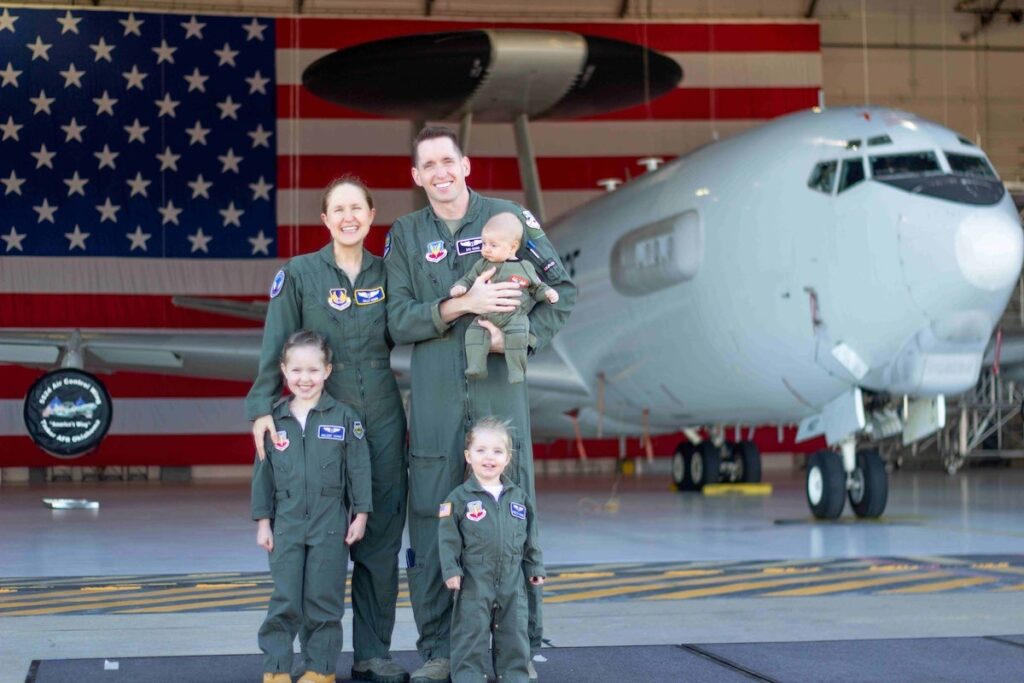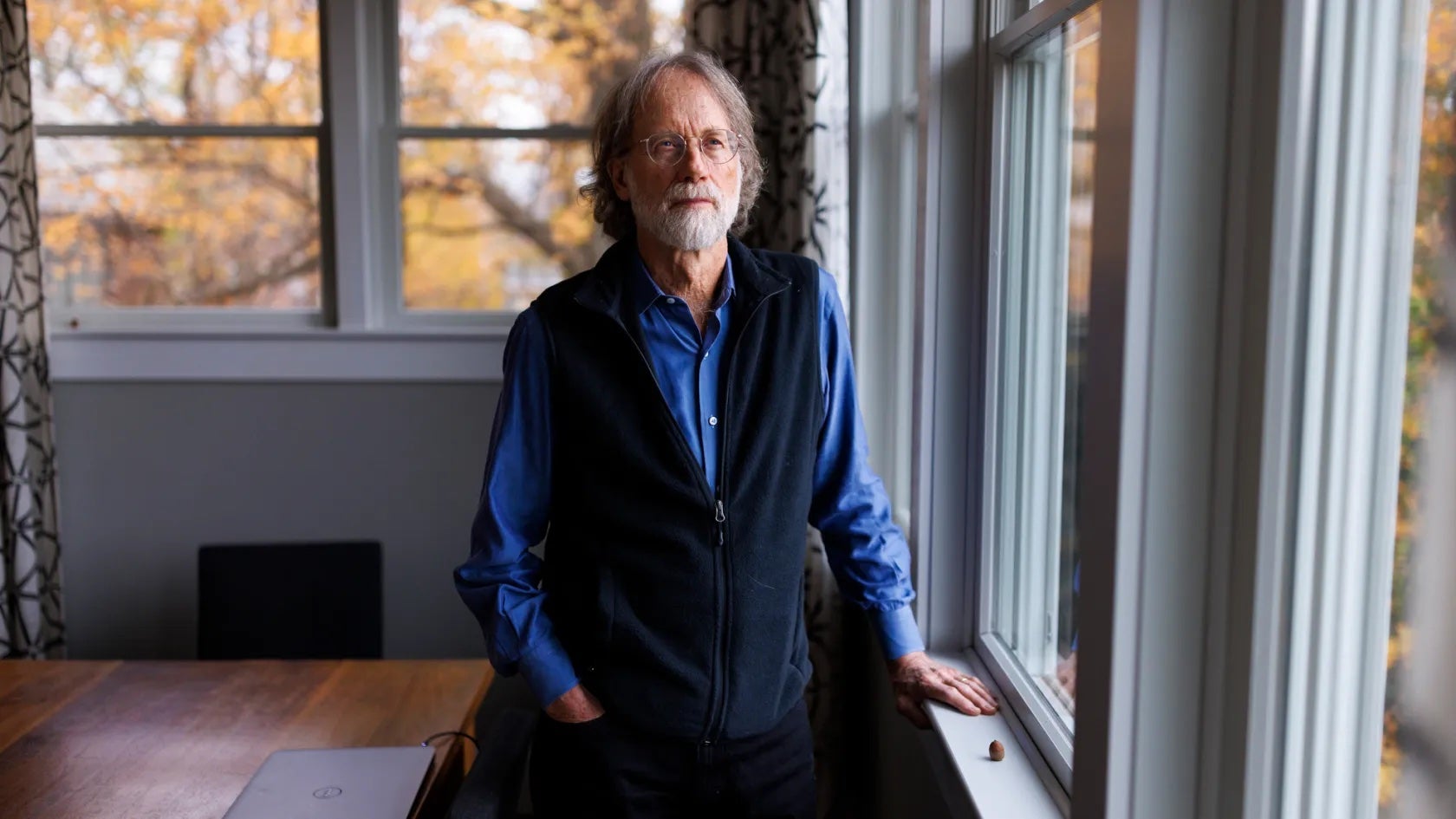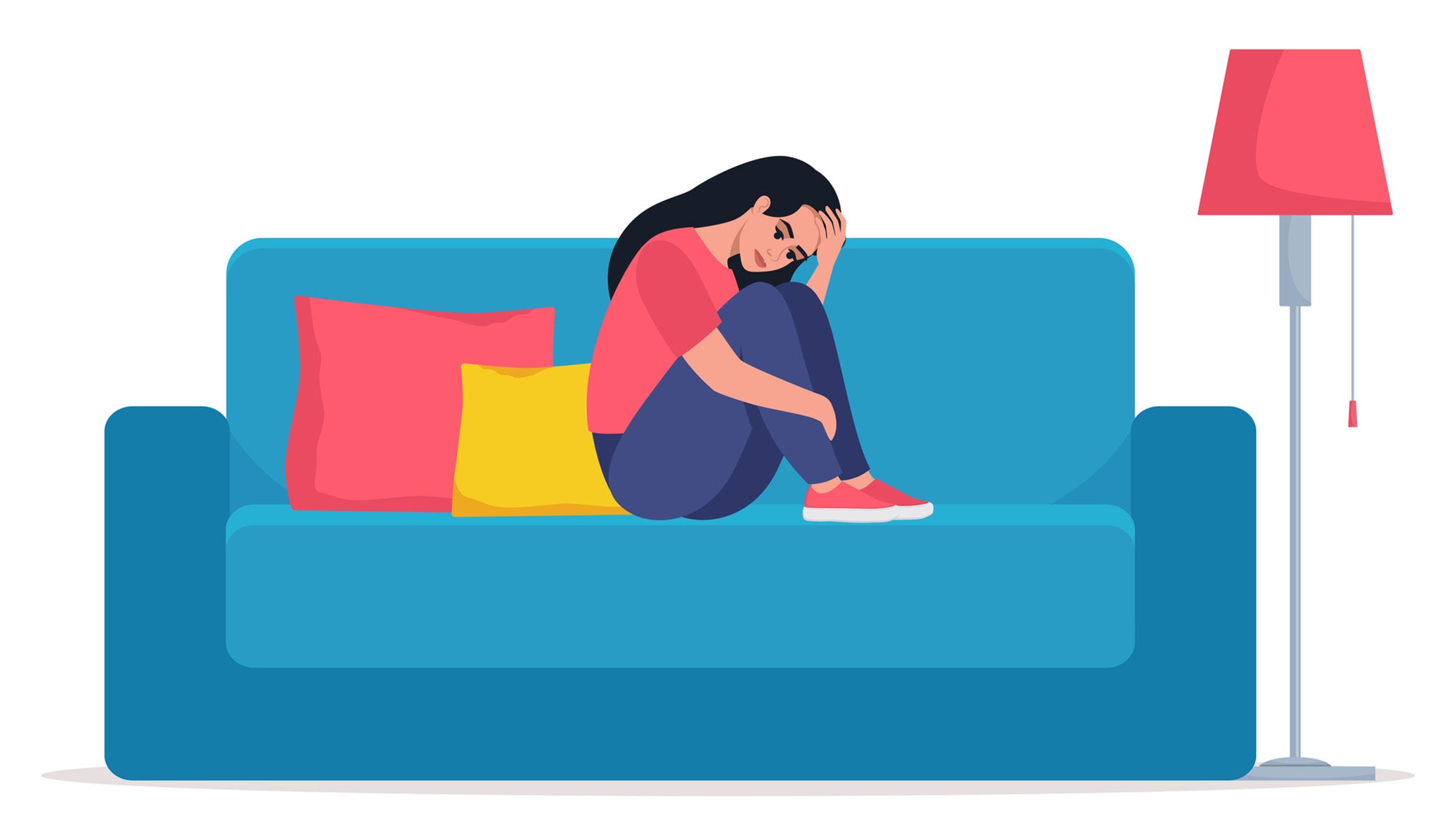Studying by day, changing diapers by night

For married students Matt Hamm and Sally Hamm, MDs who’ve worked together as Air Force flight surgeons, Harvard Chan School’s Occupational and Environmental Medicine Residency Program has provided an ideal opportunity to deepen their training while raising four kids
April 4, 2024 – Sally Hamm wasn’t about to miss her toxicology exam. So she strapped Marianne, her newest child and all of eight days old, to her chest and brought her to class.
“I had already studied for it,” she explained, “and I didn’t want to forget everything.”
Matt and Sally may be pioneers when it comes to enrolling in an occupational and environmental medicine residency program in the U.S. together (Matt says he checked with each of the programs and none could recall having married students). They chose Harvard Chan School’s program because it had a top-flight reputation and offered plenty of support and flexibility for people with children, including accommodations for time off. In fact, among the 10 students currently enrolled, there are 16 children under the age of 12. “Whether we’re dealing with the logistics of Boy Scout meetings or bouts of flu, we all support each other,” said Sally.
Occupational and environmental medicine—a sub-specialty of preventive medicine—focuses on the prevention and treatment of occupational and environmental injury, illness, and disability among workers and their families, and promotes overall safety in workplaces and environments. At Harvard Chan’s Occupational and Environmental Medicine Residency (OEMR) Program, the Hamms spent their first year in the program earning a master of public health and their second year doing clinical and administrative rotations in settings such as Boston-area government and health care sites, as well as completing a research project. They’re slated to finish their residency in June.
All of this amid busy dinnertimes, early morning piano practices, and the usual raft of doctor visits and school events for their brood of four, ages 8, 5, 3, and 1. Said Sally, “Harvard Chan School has really been a place where we’ve been able to balance being good, supportive parents, and not have to put family life on hold while pursuing bigger careers.”
From wingmen to a couple to a family
Matt and Sally met at church while both were in the Air Force attending medical school. In subsequent military assignments they worked together as flight surgeons, charged with keeping pilots and aircrew members healthy, evaluating living and working environments on aircraft and on air bases for health hazards, participating in flying missions to observe and advise on potential health issues, and managing preventive medicine programs for flight personnel. “We learned to be colleagues and friends before we fell in love,” Sally said. To describe their relationship, she talked about the concept of the “wingman” in the Air Force—a fellow pilot who you plan missions with, who often will fly wingtip to wingtip with your aircraft, who looks out for you when there’s a threat, and who is as invested in the success of your mission as you are. Said Sally, “Matt had been my wingman for years before he was my husband.”

They were married in Bethesda, Maryland in 2012. As they moved through successive military assignments, from San Antonio to Las Vegas to Indian Springs to Oklahoma City to Boston, their family grew. “Each kid was born at a different military assignment, including the present one in Massachusetts,” said Matt.
In the Air Force, they’ve flown F-16s and fired machine guns out of the back of helicopters. But beyond that training, the Air Force has given them a valuable perspective on population medicine.
“In the military you don’t just have a doctor-patient relationship; you have a doctor-community relationship,” said Sally. “You’re thinking not just of the particular pilot in front of you, but about their mission. That perspective has helped us in thinking not just about when the goal is to ‘fly, fight, and win’—the official mission of the Air Force—but also when the goal is civilian-oriented. For instance, how will a policeman fit back into their unit and protect the public if they have a particular medical condition? Or the person who repairs our power grid—how might a health condition impact their ability to do their job safely? How might it impact everyone who relies on their work?”
A ‘buffet’ of options
Matt praised the OEMR program for its practical training focused on creating leaders. “If you can imagine it, this program can equip you to achieve it,” he said. “Any topic, at any level.”
Matt has also been extremely grateful for what he calls “the buffet that is Harvard Chan School of Public Health.” He said, “This residency, the Department of Environmental Health, and the whole Harvard enterprise is really a buffet. We have unlimited options that are all incredibly delicious, different flavors, and you can have as much of it as you want. In fact, even if you tried, you could never sample everything. There’s something for everyone.” He added, “You almost wish you had more time to just learn and grow. But of course we need to do more than just become and know—we need to go out and transform and serve.”
“Through this program, we’ve learned, both through coursework and practical application, how to look at the medical management of groups of employees as well as individual patients,” said Sally. “We’ve learned how to evaluate when a system is not serving either the workers or the company. We’ve learned how to communicate to implement change.”
Matt, who separated from the Air Force in 2021 in order to keep the family geographically together, has been working as a consultant providing employer-based medical services. Through a residency opportunity at Harvard Chan School, he worked with a Fortune 100 company on how it could shape its policies to benefit both company values and employee health needs.
He also compiled a national task force aimed at boosting the ranks of specialists in occupational and environmental medicine. “It’s a very small field that does a lot of good, but not a lot of people know about it, or how to get into it,” said Matt. Task force members developed a centralized national strategy to reinvent the country’s 23 medical residency programs, recruitment, and funding efforts. They created a website, podcasts, and information sheets for dissemination to potential feeder institutions, as well as opportunities for mentorship and training. And they’ve worked to communicate the importance of the field to members of Congress.
One of Sally’s Harvard Chan practicum projects has been working as a writing and research fellow with the executive production firm BL2, which is partnering with the media company MacGillivray Freeman on an IMAX film about the human body and the scientific breakthroughs that are changing the course of human health. The film is aimed at attracting more young people into STEM fields. “I’m a bookworm—I prefer podcasts to videos—but I’ve been blown away by how fun it is to engage in scriptwriting and visual media,” Sally said.
Sally has also worked on projects focused on reproductive toxicology, health and safety of childcare facilities, and the resurgence of child labor in hazardous occupations. In another project, she studied the science behind federal guidelines on what kinds of work are safe for women during pregnancy, and she presented on that topic to occupational physicians from several countries. “If we’re serious about taking advantage of the talents and ingenuity of our whole population, then ‘mommy’ health concerns aren’t just niche issues of a special interest group—they’re fundamental workforce issues,” she said.
The mentoring and coaching available at Harvard Chan School has been a huge benefit, Sally noted. “Whenever I told a faculty member that I had an idea but wasn’t sure how to bring it to fruition, or when I didn’t know the next step, there has been somebody there who said, ‘here’s the next step,’ or ‘here’s somebody who can help you’,” she said. “Harvard provides this incredible network of faculty and alumni who are used to making things happen.”
Support network
Going forward, Matt will continue to work as an occupational health consultant with clients in a variety of sectors, as well as continue with volunteer work with the family’s religious community and with various occupational and environmental medicine professional groups. The family will relocate to San Antonio, where Sally will join one of the Air Force’s largest occupational medicine clinics, working in clinical care, population health of the base, emergency preparedness, and environmental health. On the side, she’ll also keep working on projects with BL2, such as STEM-focused cartoon shows for kids and a sitcom based on biotech.
In the meantime, Matt and Sally remain extremely grateful for the support they’ve received, both at Harvard Chan School and beyond, that has enabled them to take full advantage of the OEMR program.
“Both of us are trying to accomplish meaningful and important change in the world,” said Sally. “And meanwhile, someone is spitting up. It’s the reality of having small children. I’ve shown up for patient care with little bits of baby spit on my shoulder, and people have been so understanding. If I’ve drifted off in class because I’ve been up with a kid, someone has taken notes for me.”
She added, “Nobody does big things without helpers.”
Photos: Kent Dayton; courtesy Matt and Sally Hamm


